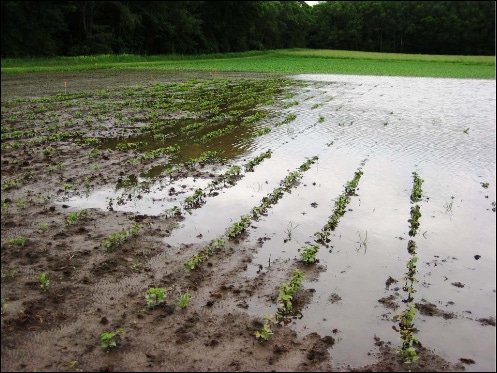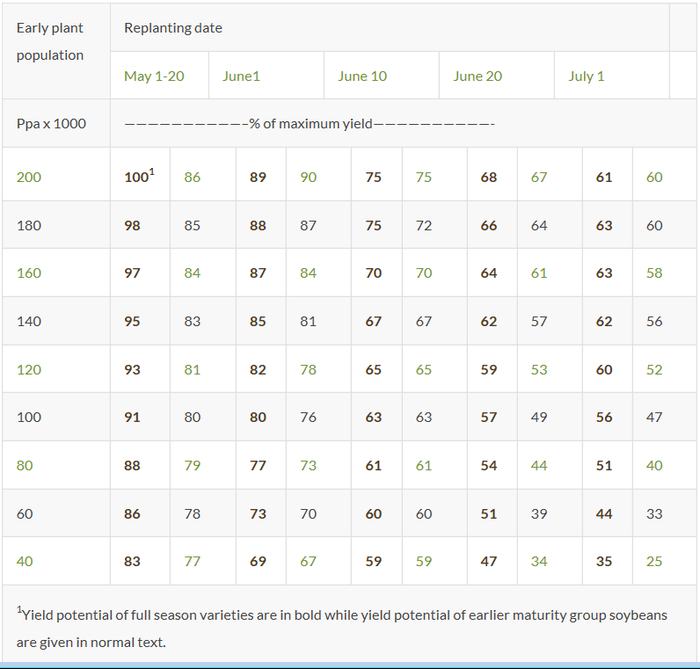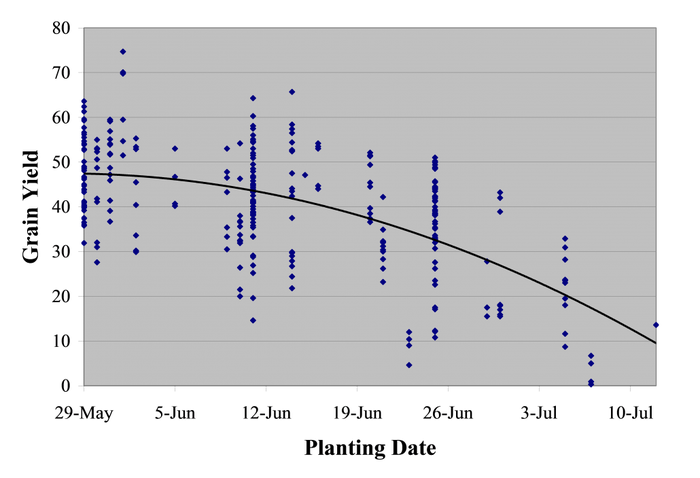June 18, 2018

Source: University of Wisconsin-Madison
Shawn Conley, State Soybean and Wheat Specialist University of Wisconsin, Madison and Grover Shannon, Emeritus Professor, University of Missouri, Division of Plant Sciences
Severe flooding over the weekend has many low-lying soybean fields underwater. As the water dissipates yield potential and replant questions will arise. Flooding can be divided into either water-logging, where only the roots are flooded, or complete submergence where the entire plants are under water (VanToai et al., 2001). Water-logging is more common than complete submergence and is also less damaging. Soybeans can generally survive for 48 to 96 hours when completely submersed. The actual time frame depends on air temperature, humidity, cloud cover, soil moisture conditions prior to flooding, and rate of soil drainage. Soybeans will survive longer when flooded under cool and cloudy conditions. Higher temperatures and sunshine will speed up plant respiration which depletes oxygen and increases carbon dioxide levels. If the soil was already saturated prior to flooding, soybean death will occur more quickly as slow soil drainage after flooding will prevent gas exchange between the rhizosphere and the air above the soil surface. Soybeans often do not fully recover from flooding injury.
Crop injury from water logging is difficult to assess. Water-logging can reduce soybean yield 17 to 43% at the vegetative growth stage and 50 to 56% at the reproductive stage (Oosterhuis et al., 1990). Yield losses are the result of reduced root growth, shoot growth, nodulation, nitrogen fixation, photosynthesis, biomass accumulation, stomatal conductance, and plant death due to diseases and physiological stress (Oosterhuis et al., 1990; VanToai et al., 1994 and 2003). A significant amount of genetic variability for flooding tolerance among soybean varieties occurs in maturity groups II and III (VanToai et al., 1994) and likely exists for maturity group I soybeans as well.
Increased disease incidence in the surviving plants may also occur and limit yield potential. The main culprit will likely be phythophthora given the warm wet weather; however phythium, rhizoctonia, or fusarium may also occur. Differential response among varieties will be tied to the sources of genetic resistance to these diseases.
Once we can get back into the fields the decision to replant will be based on the yield potential of the current stand relative to the cost and yield potential of the replanted soybean field (Table 1). Before any decision to tear up a field is made make sure you contact your crop insurance agent to discuss coverage and you have the replant seed on your farm or at least en route. Also remember to check herbicide labels for plant back restrictions if you are planning to plant soybean into a flooded corn field.
Table 1. Expected relative soybean yield at four replanting dates compared to predicted yields for a range of plant populations resulting from an optimum planting date of May 1-20 for full season maturity or short season maturity varieties.

Since full season maturity group soybeans are unrealistic for planting this late plant soybean cultivars 0.5 MG earlier than “normal”. The average yield potential for soybean planted in late June in southern WI is in the 30 to 35 bu yield range (Figure 1). For yield potential and harvestability, (a combine may not be able to pick up the lower pods) a grower should not go to an extreme early MG for their geographic area.
To maximize yield potential in late planted soybean, a minimum of 180,000 plants per acre is required in narrow row system (<20 inches) as yield potential in rowed beans would be significantly reduced due to decreased canopy development. To achieve 180,000 plants per acre a grower may have to seed as many as 225,000 seeds per acre.

Literature Cited:
Borges, R. (2004). Soybean management and excessive soil moisture.
Boru, G., T. Vantoai, J. Alves, D. Hua, and M. Knee. 2003. Responses of Soybean to Oxygen Deficiency and Elevated Root-zone Carbon Dioxide Concentration. Annals of Botany, 91: 447-453.
Neave, S. 2002. Flooded Fields and Soybean Survival. MCCN80. www.plpa.agri.umn.edu/extension.
Oosterhuis, D.M. H.D. Scott, R.E. Hampton and S.D. Wullschleger 1990. Physiological response of two soybean [Glycine max, (L.) Merr.] cultivars to short term flooding. Env. Exp. Bot. 30:85-92.
Shannon, G., W. E. Stevens, W. J. Wiebold, R. L. McGraw, D. A. Sleper, and H.T. Nguyen, 2005. Breeding Soybeans for Improved Tolerance to Flooding. Proceedings ASTA Meetings.
VanToai, T.T., J.E. Beuerlien, A.F. Schmithenner, and S.K. St. Martin, 1994. Genetic variability for flooding tolerance in soybeans. Crop Sci. 34:1112-1115.
VanToai, T.T., S. K. St. Martin, K. Chase, G. Boru, V. Schnipke, A. F. Schmitthenner, and K. G. Lark. (2001) Identification of a QTL associated with tolerance of soybean to soil water-logging. Crop Sci. 41,1247-1252.
VanToai, T. Y. Yang, P. Ling, G. Boru, M. Karica, V. Roberts, D. Hua, B. Bishop.(2003) Monitoring soybean tolerance to flooding stress by image processing technique. In T.T. VanToai, et al. (ed) Digital Imaging and Spectral Techniques: Applications to Precision Agriculture and Crop Physiology. ASA Special Publication No 66. The American Society of Agronomy. Madison, WI. Pp 43-51.
Originally posted by the University of Wisconsin-Madison.
You May Also Like




